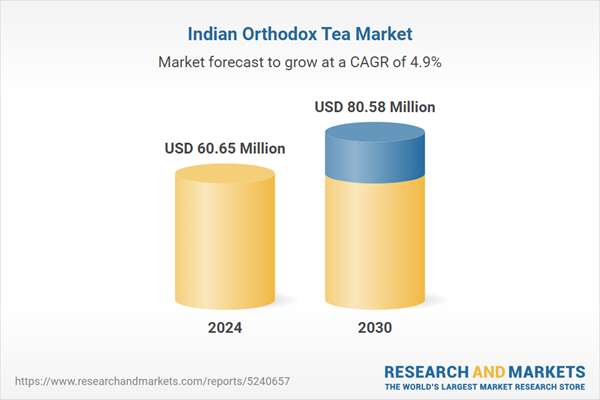Speak directly to the analyst to clarify any post sales queries you may have.
10% Free customizationThis report comes with 10% free customization, enabling you to add data that meets your specific business needs.
Key Market Drivers
Rising Global Demand for Premium and Specialty Teas
The surge in global demand for premium and specialty teas is a key factor propelling the India Orthodox Tea Market. Orthodox teas are manufactured using traditional methods that retain the integrity of the whole leaf, offering superior flavor, aroma, and quality over standard CTC (Crush, Tear, Curl) teas. This appeals to health-conscious and discerning consumers in markets like the U.S., EU, Japan, and the Middle East, where there is a preference for organic, minimally processed teas. India became the third-largest tea exporter globally in 2024, exporting 254.7 million kg of tea, a rise from 231.69 million kg in 2023, surpassing Sri Lanka. Consumers in regions such as Germany and the UK increasingly favor Indian Orthodox teas from GI-certified regions like Darjeeling and Nilgiris for their authenticity and traceability. This rising demand for high-grade teas incentivizes Indian producers to enhance quality and scale up orthodox manufacturing to tap into lucrative export opportunities.Key Market Challenges
Climate Change and Unpredictable Weather Patterns
Climate change poses a significant threat to the India Orthodox Tea Market, particularly in core growing regions such as Darjeeling, Nilgiris, and Assam. Orthodox tea cultivation depends on consistent altitude, temperature, and humidity conditions to preserve the unique flavor and aroma profiles expected in premium exports. However, erratic rainfall, temperature fluctuations, and prolonged dry spells are negatively impacting yields and tea quality. These environmental stressors also lead to increased incidences of pests and diseases, driving up production costs and reducing farmer profitability. Smaller growers, in particular, face challenges adapting to these changes due to limited access to advanced irrigation or pest control infrastructure. The overall result is a strain on supply consistency and the ability to meet strict international standards, especially in export markets where quality control is paramount.Key Market Trends
Growth of Organic and Sustainable Orthodox Teas
A major trend shaping the India Orthodox Tea Market is the rising demand for organic and sustainably sourced teas. Consumers, especially in North America, Europe, and parts of Asia, are increasingly opting for teas free from synthetic chemicals and grown using eco-friendly practices. In response, Indian estates and small-scale growers are transitioning to organic cultivation and acquiring certifications such as USDA Organic, EU Organic, and Rainforest Alliance.These certifications enhance credibility and enable access to premium pricing tiers. Regions like Darjeeling and Nilgiris are leading this shift, promoting clean farming methods and leveraging their natural heritage. Ethical concerns around labor, biodiversity, and sustainable packaging are also influencing purchasing decisions, with brands focusing on biodegradable materials and transparent sourcing practices. This trend is expanding the global appeal of Indian Orthodox teas and positioning them as responsible, high-quality alternatives in the premium tea category.
Key Market Players
- Tata Sons Private Limited
- Harrisons Malayalam Limited
- The United Nilgiri Tea Estates Co Ltd.
- Teesta Valley Tea Company
- Kanan Devan Hills Plantations Company Private Limited
- Kangra Valley Herbals Products
- Dharamsala Tea Company
Report Scope:
In this report, the India Orthodox Tea Market has been segmented into the following categories, in addition to the industry trends which have also been detailed below:India Orthodox Tea Market, By Product Type:
- Oolong
- White
- Green
- Black
India Orthodox Tea Market, By Distribution Channel:
- Supermarkets/Hypermarkets
- Departmental Stores
- Online
- Others
India Orthodox Tea Market, By Region:
- North
- South
- East
- West
Competitive Landscape
Company Profiles: Detailed analysis of the major companies present in the India Orthodox Tea Market.Available Customizations:
With the given market data, the publisher offers customizations according to a company's specific needs. The following customization options are available for the report.Company Information
- Detailed analysis and profiling of additional market players (up to five).
This product will be delivered within 1-3 business days.
Table of Contents
Companies Mentioned
- Tata Sons Private Limited
- Harrisons Malayalam Limited
- The United Nilgiri Tea Estates Co Ltd.
- Teesta Valley Tea Company
- Kanan Devan Hills Plantations Company Private Limited
- Kangra Valley Herbals Products
- Dharamsala Tea Company
Table Information
| Report Attribute | Details |
|---|---|
| No. of Pages | 80 |
| Published | July 2025 |
| Forecast Period | 2024 - 2030 |
| Estimated Market Value ( USD | $ 60.65 Million |
| Forecasted Market Value ( USD | $ 80.58 Million |
| Compound Annual Growth Rate | 4.8% |
| Regions Covered | India |
| No. of Companies Mentioned | 7 |









